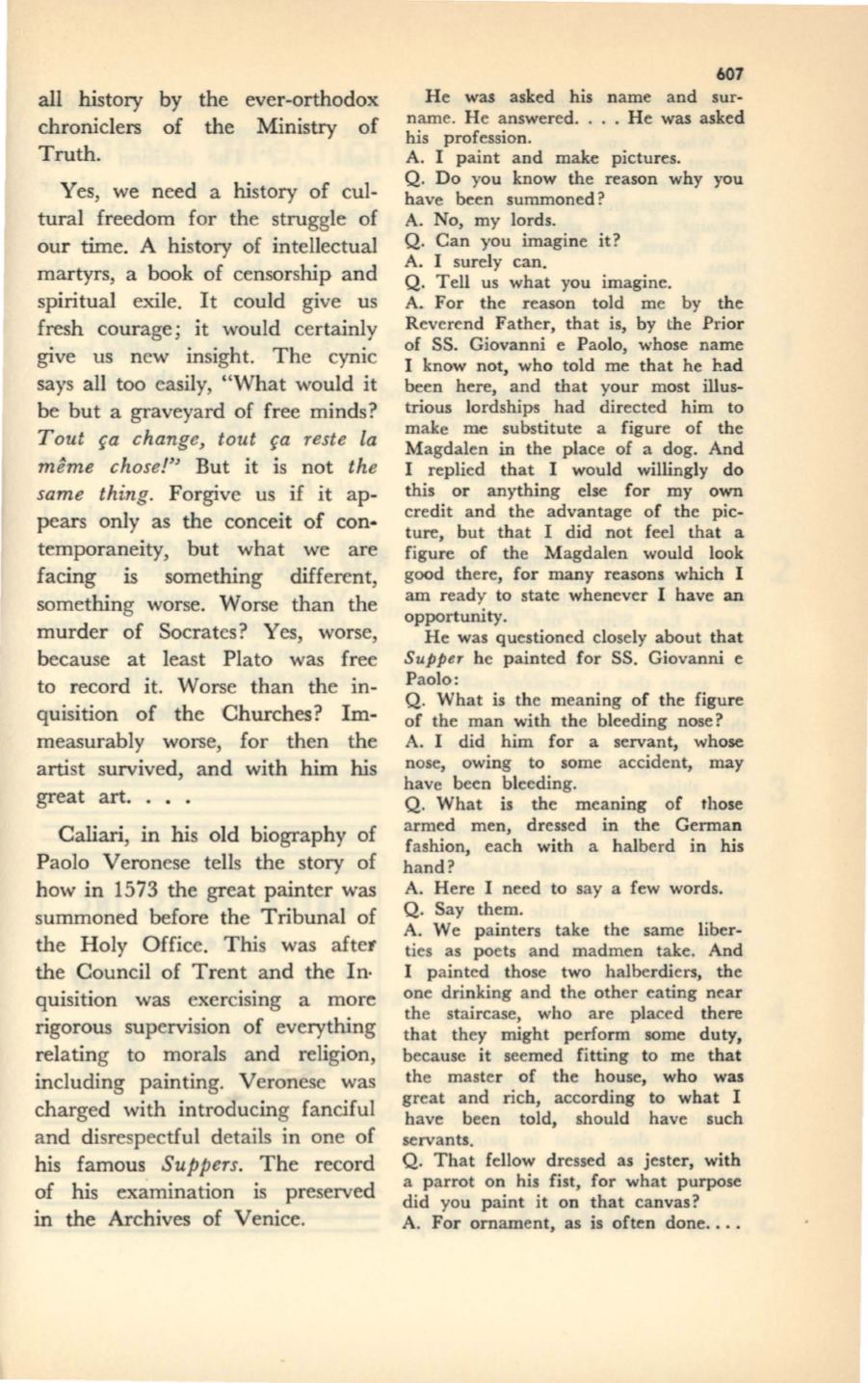
all history
chroniclers
Truth.
by the ever-orthodox
of the Ministry of
Yes, we need a history of cul–
tural freedom for the struggle of
our time. A history of intellectual
martyrs, a book of censorship and
spiritual exile. It could give us
fresh courage; it would certainly
give us new insight. The cynic
says all too easily, "What would it
be but a graveyard of free minds?
Tout
fa
change, tout
fa
reste La
meme chose!"
But it is not
the
same thing.
Forgive us if it ap–
pears only as the conceit of con–
temporaneity, but what we are
facing is something different,
something worse. Worse than the
murder of Socrates? Yes, worse,
because at least Plato was free
to record it. Worse than the in–
quisition of the Churches? Im–
measurably worse, for then the
artist survived, and with him his
great art.
Caliari, in his old biography of
Paolo Veronese tells the story of
how in 1573 the great painter was
summoned before the Tribunal of
the Holy Office. This was after
the Council of Trent and the In·
quisition was exercising a more
rigorous supervision of everything
relating to morals and religion,
including painting. Veronese was
charged with introducing fanciful
and disrespectful details in one of
his famous
Suppers.
The record
of his examination is preserved
in the Archives of Venice.
607
He was asked his name and sur–
name. He answered.... He was asked
his profession.
A. I paint and make pictures.
Q.
Do you know the reason why you
have been summoned?
A. No, my lords.
Q. Can you imagine it?
A. I surely can.
Q. Tell us what you imagine.
A. For the reason told me by the
Reverend Father, that is, by the Prior
of SS. Giovanni e Paolo, whose name
I know not, who told me that he had
been here, and that your most i1lus–
trious lordships had directed him to
make me substitute a figure of the
Magdalen in the place of a dog. And
I replied that I would willingly do
this or anything else for my own
credit and the advantage of the pic–
ture, but that I did not feel that a
figure of the Magdalen would look
good there, for many reasons which I
am ready to state whenever I have an
opportunity.
He was questioned closely about that
Supper
he painted for SS. Giovanni e
Paolo:
Q.
What is the meaning of the figure
of the man with the bleeding nose?
A. I did him for a servant, whose
nose, owing to some accident, may
have been bleeding.
Q.
What is the meaning of those
armed men, dressed in the German
fashion, each with a halberd in his
hand?
A. Here I need to say a few words.
Q.
Say them.
A. We painters take the same liber–
ties as poets and madmen take. And
I painted those two halberdiers, the
one drinking and the other eating near
the staircase, who are placed there
that they might perform some duty,
because it seemed fitting to me that
the master of the house, who was
great and rich, according to what I
have been told, should have such
servants.
Q.
That fellow dressed as jester, with
a parrot on his fist, for what purpose
did you paint it on that canvas?
A. For ornament, as is often done....


